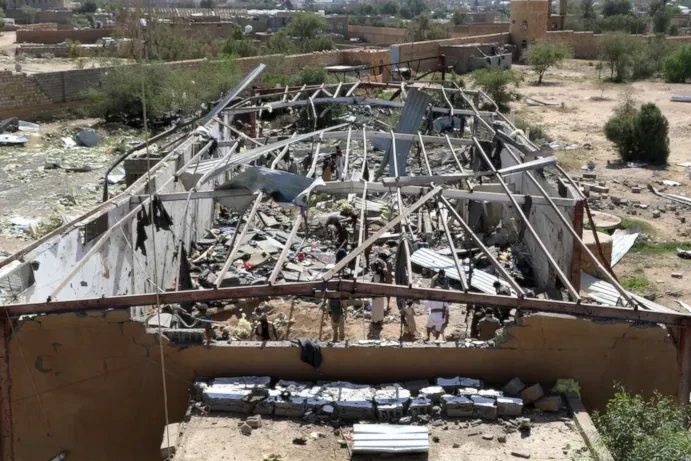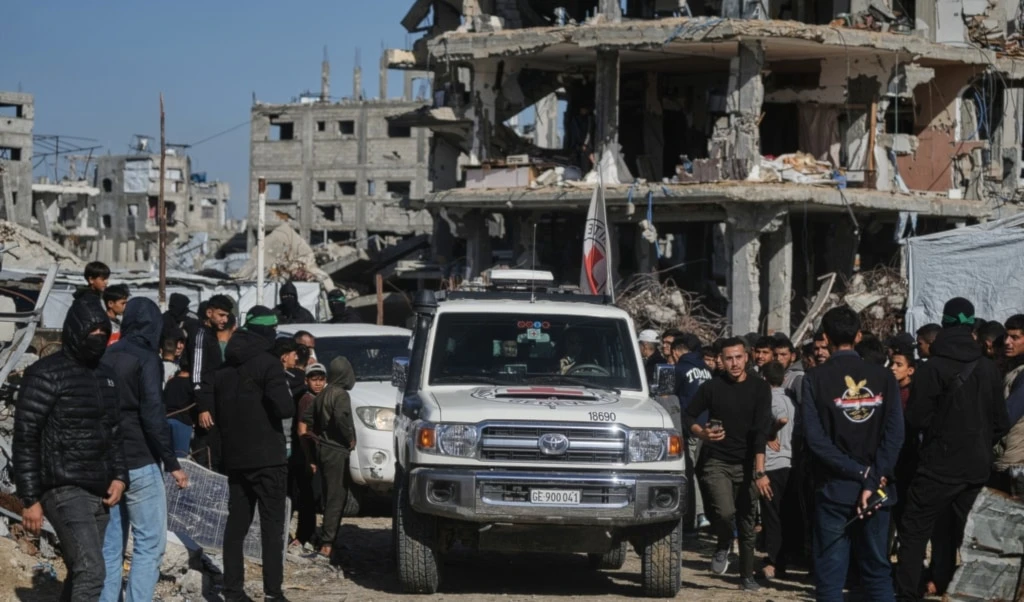Visual evidence incriminates US in Yemen detention center carnage
The Washington Post's analysis of aftermath visuals reveals dozens killed in a US strike on a migrant compound in Yemen, raising questions about civilian harm and targeting.
-

Yemenis inspect the rubble of a building hit by US strikes in the northern province of Saada on April 29, 2025. (AFP/Getty Images)
A US airstrike on April 28 reportedly struck a compound in Yemen, killing at least three dozen individuals, according to an analysis of aftermath visuals by The Washington Post. The site appeared devastated in the imagery reviewed.
Photos from the scene of the strike published by Yemen’s Mine Action Program, YEMAC, show fragments of US-made GBU-39 bombs, according to Trevor Ball, a former Army explosive ordnance disposal technician, as reported by The Washington Post. At least two fuze wells indicate that at least two munitions were used in the attack.
The Ansar Allah movement stated that at least 68 people were killed and dozens more wounded in what they described as a US strike on a detention facility housing African migrants. The Washington Post's review of available visuals identified 38 apparent fatalities and 32 injured individuals, figures likely to underestimate the full toll due to limited imagery access.
The Post reported that no military gear or personnel were visible in the footage and that only one of the two destroyed buildings could be clearly analyzed. The strike comes amid ongoing Yemeni attacks targeting US and Israeli interests in response to the ongoing Israeli war on Gaza.
As part of its campaign, the Trump administration launched "Operation Rough Rider" in mid-March, allegedly focusing on military targets in Yemen, with inside reports showing attacks mainly focused on civilian infrastructure.
US claims, targeting concerns
Central Command, which oversees US operations in the Middle East, has not said what it was targeting in the strike in question but is “aware of the claims of civilian casualties” and is assessing them, a defense official has said. The US military has alleged its Yemen operations are executed with “detailed and comprehensive intelligence” to minimize risk to civilians.
Meanwhile, analysts and current and former US officials said the strike appears to add to mounting evidence that the Trump administration has not prioritized minimizing civilian casualties in its ongoing air campaign. The Defense Department is moving to dismantle efforts focused on reducing civilian harm in US military operations, The Post has reported, so commanders can focus more on “lethality” when conducting military strikes.
“This strike in particular and the campaign in Yemen in general clearly show a higher tolerance for civilian casualties than previously seen in Yemen and even in the wars against ISIS,” a US official familiar with the campaign said as quoted by The Washington Post, speaking on the condition of anonymity to discuss ongoing operations. The same official confirmed that Monday’s strike was carried out by the United States.
History and use of the Saada compound
The United Nations has described the compound as having once included a military barracks and, more recently, a migrant detention center. One human rights researcher told The Post that it ceased serving military purposes a decade ago. Emergency workers sifting through the debris to look for survivors saw scattered mattresses, clothes, and plastic bowls.
Satellite imagery taken after the strike in the southwest outskirts of the city of Saada shows two large buildings destroyed inside a walled compound occupying about 50 acres, known as Saada City Remand Prison. Both buildings are similar in design and about 120 feet long and just over 500 feet apart, separated by a road.
Ansar Allah reportedly used the detention center in northwestern Yemen for military purposes up until 2015 or 2016, when it was converted to a prison, said a Yemeni human rights researcher who spoke on the condition of anonymity, as reported by The Washington Post. This negates US claims of targeting a military facility.
Speaking about the US military, Christopher Le Mon, former deputy assistant secretary of state for democracy, human rights, and labor in the Biden administration, told The Washington Post, “It’s just inconceivable that the military wouldn’t have anticipated a serious risk of civilian casualties.”
Eyewitness accounts and humanitarian concerns
An ICRC delegation visited the site on Monday following the strike. The ICRC said teams from the Yemen Red Crescent Society had evacuated wounded migrants to two hospitals nearby.
Travelers from African countries have transited through the desert corridor for decades, according to a 2023 Human Rights Watch report, which estimated that more than 90 percent of those en route to Saudi Arabia come from Ethiopia.
“African migrants locked up in a prison in northern Yemen are not a lawful military objective,” said Brian Finucane, a former legal advisor at the State Department, noting that the US military has not publicly identified what its target was or whether it was a mistake.
The number of civilians killed in Yemen has exponentially increased in the weeks since the campaign began. According to Airwars, a Britain-based watchdog organization, US strikes were estimated to have killed 27 to 56 Yemeni civilians in March. The casualty toll in April to date is believed to be much higher.
The Yemeni Armed Forces said more than 70 people were killed by an airstrike on an oil port on April 18. After Monday’s strike, a video released by Yemen's Al-Masirah television channel showed remnants of munitions and what appeared to be at least two craters where the building once stood. The visual evidence indicates multiple US-manufactured GBU-39s were dropped, said Trevor Ball, a weapons expert.
Pentagon spokesperson Sean Parnell said Tuesday the US has struck 1,000 targets, or about 23 per day, since March 15. That pace has raised questions among some experts about whether commanders and analysts can properly assess targets. “They’ve had some questionable strikes already, and with the operation tempo, chance of mistakes and shortcuts are just going to increase,” Ball said as reported by The Washington Post.
Democratic lawmakers last week said they were alarmed by what they called an apparent “serious disregard” for innocent life following reports of killings in other strikes.
Read more: Behind the bombs: Trump admin. covers up US casualties in Yemen war

 6 Min Read
6 Min Read








